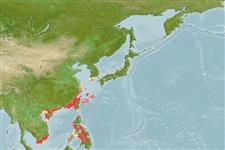Environment: milieu / climate zone / depth range / distribution range
экология
морской ассоциированный с рифами; пределы глубины 15 - 30 m (Ref. 90102). Tropical; 35°N - 8°N, 105°E - 128°E (Ref. 5222)
Western Pacific: southern Japan to Taiwan, China including Hainan, Hong Kong, Viet Nam, Philippines, and Sarawak, Malaysia.
Size / Вес / Возраст
Maturity: Lm ? range ? - ? cm
Max length : 30.0 cm TL самец/пол неопределен; (Ref. 5222); common length : 20.0 cm TL самец/пол неопределен; (Ref. 9137)
колючие лучи спинного плавника (общее число) : 11; членистые (мягкие) лучи спинного плавника (общее число) : 15 - 17; колючие лучи анального плавника: 3; членистые (мягкие) лучи анального плавника: 7 - 8. Distinguished by having grey brown color shading to whitish, yellowish or pink ventrally; head and body with numerous small yellowish brown, orange brown or brown spots; in juveniles and subadult, five slightly oblique brown bars on body that bifurcate ventrally; ctenoid body scales except cycloid anterodorsally above lateral line and on thorax and abdomen; body with auxiliary scales; greatest depth of body 2.8-3.3 in SL; rounded caudal fin; pelvic fins 1.9-2.3 in head length (Ref. 90102); further characterized by having a slightly convex interorbital area and dorsal head profile; angular preopercle, serrae at the angle slightly enlarged; straight upper edge of operculum; subequal posterior and anterior nostrils; maxilla reaching about below rear third of eye or a little past eye; 2-3 rows of subequal teeth on midlateral part of lower jaw (Ref. 89707).
Inhabits shallow rocky areas and feeds on small fishes, prawns, crabs, worms, and gastropods (Ref. 89707). An excellent food fish and brings a good price. Solitary, found in rocky bottoms in 15-30 m (Ref 90102).
Life cycle and mating behavior
Maturities | размножение | Spawnings | Egg(s) | Fecundities | личинки
Heemstra, P.C. and J.E. Randall, 1993. FAO Species Catalogue. Vol. 16. Groupers of the world (family Serranidae, subfamily Epinephelinae). An annotated and illustrated catalogue of the grouper, rockcod, hind, coral grouper and lyretail species known to date. Rome: FAO. FAO Fish. Synop. 125(16):382 p. (Ref. 5222)
Статус Красного Списка МСОП (Ref. 130435)
Угроза для людей
Harmless
Использование человеком
рыболовство: коммерческий
дополнительная информация
инструменты
Специальные отчеты
Скачать в формате XML
ресурсы в Интернет
Estimates based on models
Preferred temperature (Ref.
123201): 21.9 - 28.4, mean 27.1 °C (based on 52 cells).
Phylogenetic diversity index (Ref.
82804): PD
50 = 0.5000 [Uniqueness, from 0.5 = low to 2.0 = high].
Bayesian length-weight: a=0.01175 (0.00571 - 0.02419), b=3.04 (2.88 - 3.20), in cm total length, based on LWR estimates for this Genus-body shape (Ref.
93245).
Trophic level (Ref.
69278): 3.6 ±0.58 se; based on food items.
устойчивость к внешним воздействиям (Ref.
120179): средний (среднего размера), минимальное время удвоения популяции 1.4-4.4 года (Preliminary K or Fecundity.).
Fishing Vulnerability (Ref.
59153): Low vulnerability (20 of 100).
Nutrients (Ref.
124155): Calcium = 42.6 [20.2, 89.3] mg/100g; Iron = 0.564 [0.311, 1.172] mg/100g; Protein = 18.4 [16.8, 19.7] %; Omega3 = 0.122 [0.076, 0.195] g/100g; Selenium = 27.2 [15.5, 47.6] μg/100g; VitaminA = 228 [62, 819] μg/100g; Zinc = 1.6 [1.1, 2.2] mg/100g (wet weight);
